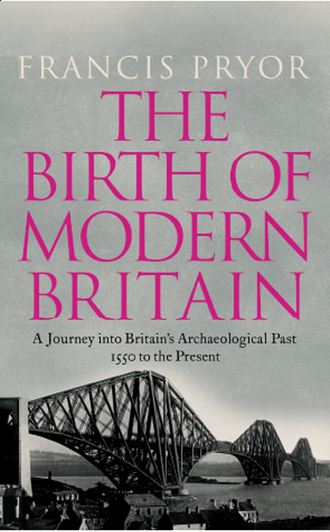
Полная версия
The Birth of Modern Britain: A Journey into Britain’s Archaeological Past: 1550 to the Present
There is, of course, always a danger when considering the archaeology of the recent past to become overwhelmed with detail. As a prehistorian I routinely recover a large proportion of the surviving debris from, say, a Bronze Age settlement. That might amount to 5,000 pieces of flint, maybe 200 potsherds and 10,000 bone fragments – half of which could prove identifiable. But today the amount of rubbish being produced by even a small-sized town can rapidly fill huge landfill sites. In such instances the best one can hope to do is to sample what is being discarded and for several years a team of archaeologists in Arizona did just that: in the Garbage Project they sampled what the city of Tucson was discarding day by day.3 But, again, it’s all very well to sample, but what really matters are the problems you are trying to resolve when you come to analyse the samples. That is undoubtedly why today historical archaeologists have grown increasingly aware that the questions they are posing must be closely tied down and tightly defined. It is no longer regarded as sufficient simply to study, say, steam engines for their own sake, because such myopic attention to detail will only tell us more and more about less and less. Instead, a historical archaeologist might try to understand the social impact of steam power: why did it become so significant and what were the effects its adoption had on the lives of people, not just in the factories where the engines were built, but in the towns and villages where the new, mass-produced goods it helped to produce were sold?
It has been said many times that archaeology is a very broad church and this is particularly true for the post-medieval period.4 Some specialists have arrived in historical archaeology from their studies of the later Middle Ages; others, often excavators, have grown interested in those upper layers that in the past were given only passing attention on the way down to the supposedly more interesting ancient deposits closer to the bottom of the trench. Many have joined the ranks through more specialist research interests in, say, pottery, or churches. Some have come from outside archaeology altogether – and here I would include those many industrial archaeologists who have come to the subject through their concerns for old mines, factories, vehicles or machinery and the urgent need to protect and preserve them.
As time passes it would seem that the ‘glue’ that will bind these different strands together will be social. In other words, how did people in the past react to a particular stimulus, be it a new chapel, coal mine, crop rotation or steam engine? That, surely, is the key question. Because when all is said and done, chapels, mines, farming methods and machines are of little interest in themselves. Like, dare I say it, flint tools and Bronze Age weapons, they only come alive when they can be related to society and to people.
Earlier I mentioned the distinction between the sources of information drawn upon by archaeologists and historians, namely artefacts and documents. And here I must also admit that there has been a tendency among archaeologists to regard their information, perhaps because it is so very ‘bottom-up’ and derived from the ground, as somehow more reliable than written accounts, which we all know can be distorted in favour of a particular opinion. As a prehistorian I have the enormous luxury – actually it’s a responsibility, too – of working with data whose analysis cannot be challenged by documentary sources, simply because writing didn’t exist at the time. This makes it much harder to contest my conclusions, but that doesn’t make them more reliable. So I still think it important to emphasise that it is just as easy to be misled by a spread of coal and clinker in what might once have been an engine room, as by the letters written by an eighteenth-century ironmaster to his bankers. There is nothing in the ‘bottom-up’ nature of archaeological observations that makes them necessarily more truthful than conventional historical sources. Both are different, that’s all. It goes without saying that both, too, need to be treated with caution and care. I think one reason why historical archaeology is so exciting is the creative tension that appears at the moment, often late in the life of a project, when the written record is set against that from the ground. This is often when a new revelation suddenly becomes apparent.
One might suppose that the very abundant documentary records of the historical period mean that less attention need be paid, for example, to science. But in actual fact many written records don’t address what people thought obvious at the time. So a factory manager doesn’t describe all the details of a process when he purchases a new machine. He just goes ahead and orders one. This means that we must still employ some remarkably sophisticated techniques of scientific analysis if we are to understand what precisely was being manufactured and how it was done. Often, as we will see in Chapter 5 (when we examine the Moffat Upper Steam Forge, near Airdrie), this can be achieved through the careful analysis of material preserved on the floors of long-abandoned workshops. In my experience it’s not always a straightforward matter to distinguish between these industrial deposits and the floors themselves. Again, the scientists in the laboratory can suggest which was what.5
By far and away the most productive approach to the historical past is collaborative: thorough excavation and survey combined with detailed documentary research. Certainly when it comes to the study of topics such as the trade in pottery or, indeed, in slaves, bills of lading, receipts and invoices can throw much-needed light on the thousands of potsherds and clay pipe stems found around the excavated sites of the period. I would go so far as to say that excavation without documentary research would almost certainly prove useless – or, worse, it could do serious damage to an important site.
Many people have heard about industrial archaeology and I quite frequently get asked about it. Most want to know what it is and when it got going. In fact, it has not been around for very long at all. The first widely accepted textbook on the subject traces it back to an article in the Amateur Historian for 1955.6 The origins of industrial archaeology were diverse. They included a few academic historians and archaeologists with an interest in historical archaeology, but the majority were part-time enthusiasts, some of them active in, or recently retired from, engineering and industry, who were worried that so much evidence for the recent past was being needlessly destroyed by the rapid reconstruction of Britain in the early post-war decades. These enthusiasts covered a huge range of interests, ranging from railways to shipping, mining, road transport and heavy industry. In most instances their enthusiasm was centred on a particular site, usually, but not always, somewhere near where they lived or worked: towns like Coalbrookdale, even entire railways (such as the Great Western). Keen hard-working volunteers, often travelling long distances, helped to record and restore some of the most remote industrial monuments in Britain, such as the abandoned mines of Cornwall or Derbyshire. Inevitably, too, the emphasis tended to be on machines and mechanisms – where much of their expertise, often based on practical experience, lay. Far less attention was paid to the lives of the people who built, maintained and used these things. The machines also tended to be seen as objects in their own right, without, as we have seen, much attempt being made to reconstruct their social setting.
It’s worth noting here that even the best known of the abandoned monuments to Britain’s industrial past were slow to be protected under the Ancient Monuments Protection Act of 1882. Even the great iron bridge of Ironbridge, Shropshire, was not given statutory protection by Scheduling until 1934 and was only taken into Guardianship (i.e. public ownership, display and administration) as late as 1975. The following year the iron-making furnace at Coalbrookdale was at last Scheduled, almost exactly two hundred years after its final major rebuilding by the great ironmaster Abraham Darby in 1777. In retrospect the archaeological establishment was extraordinarily slow to protect the remains of the Industrial Revolution, and this despite one of the greatest acts of official Philistinism in the twentieth century.
The great Doric portico, universally known as the Euston Arch, was demolished in 1962 by the Transport Commission who believed it stood in the way of commercial success. I can remember standing beneath its towering columns and staring up at the classical entablature (not that I knew the word, of course) high above my head. And I can remember wondering why there wasn’t a building directly behind it, as there was at, say, the British Museum. In my child’s mind I couldn’t grasp, any more than could the bureaucrats and politicians of the 1960s, that the great portico heralded the world’s first main line between major cities. It was more than a mere symbol: it was a metaphor for what was to follow. And we tore it down.
There was massive public outcry at what is still seen as an act of wilful destruction, and this despite letters to the then Prime Minister, Harold Macmillan. The anger was not just that a fine building of 1835 was being unnecessarily destroyed, but it was a building that had come to symbolise the confidence of the Railway Age and ultimately Britain’s role in the Industrial Revolution.7 It was built by Philip Hardwick to be a triumphal entrance to the London to Birmingham railway and it was intended to impress – which undoubtedly it did.
The fight to prevent the powers that be from destroying the Euston Arch drew everyone involved in industrial archaeology together. Right across Britain, new societies were established involving academics, students, amateurs and professionals. As a result the support for this form of archaeology is probably more broadly based than any other branch of the subject. At first this diversity was seen by many in the academic world as a weakness. But today we generally view such things rather differently; indeed, industrial archaeology is becoming one of the more intellectually rigorous branches of the discipline, yet one which benefits greatly from the hands-on approach of its many part-time helpers. By now the bias in favour of machines over people has largely been addressed and quite soon the adjective ‘industrial’ will slip from general use.
Today industrial archaeology is seen as a branch of post-medieval archaeology which was the last of the major period societies to come into existence. The Prehistoric Society was the first (1935) and the Society for Medieval Archaeology appeared in the post-war years (1957). Just ten years after that (and five years after the destruction of the Euston Arch), in 1967, the Society for Post-Medieval Archaeology was founded. Its journal, Post-Medieval Archaeology, is still the bible for anyone with a serious interest in the period.
My own enthusiasm for industrial archaeology goes back some time and owes much to some remarkable people. Ever since I was a child and enjoyed making things with Meccano kits I have admired engineers. I suppose like most boys I grew up almost worshipping men like Brunel and Telford and I can well remember my maternal grandmother, née Nora Parsons, telling me wonderful stories about our relative Sir Charles Parsons as he steered his Turbinia (built in 1897), the first steam-turbine-powered vessel and then by far and away the fastest ship afloat, through the great dreadnoughts at the famous display of British naval might at Spithead. I loved the way he cocked a snook at the naval establishment who were then obliged to commission a turbine-powered vessel from his yard.
One of the first real live engineers to cross my path was a remarkable and very eccentric gentleman who was a distant relative, an old friend of the family and my godfather. He was a lovely man, but a hopeless godfather, at least as far as God was concerned. His name was Julian Turnbull. I first came across him when I was about ten. At the time he worked for the Iraq Petroleum Company, where he specialised in putting out desert oil rig fires, with explosives. Today he would be described as partially sighted and wore glasses with extraordinarily thick lenses. Even then I remember thinking that these must have inhibited his work in the blowing sands of Arabia.
He and his wife Dorothy lived in a tiny bungalow in Barnet and I recall my first visit to the shed at the bottom of his garden as clearly as my first step into the great nave of Ely Cathedral. It was impeccably organised, with spanners arranged in order of size, their outlines painted in black against a white background, doubtless to help his failing sight return them to their correct position. But the most remarkable feature of this quite small (maybe 15 x 8 feet) shed was his collection of screwdrivers, which in those days were all wooden-handled. It was vast and must have included hundreds – no, thousands – of examples which ranged from something shovel-sized, used by marine engineers, to a series of minute watchmakers’ tools. The largest was about six foot long and next to it was one a bit smaller and a bit smaller, and so on and so on, until the hut walls had been encircled two or three times. I adored those screwdrivers.
In the middle of the hut was an old Atco lawnmower which Julian had converted to steam power, using the case of a wartime howitzer shell he had found in the desert as a boiler. All the pipes and pistons were lovingly lagged with carefully coiled string. I only saw it operate once on his tiny lawn. But once was more than enough. It belched prodigious quantities of coal smoke and sparks while its almost blind operator blundered around behind it, spending more time wrestling with its handlebars on the weed-choked flowerbeds than the lawn. After ten minutes of mayhem I asked him whether it gave a good cut. He said he had no idea about that, but the hot coals seemed to keep grass growth to a minimum for several weeks. So I suppose it did work after a fashion.
The second person was very different but no less inspiring. Today he is very well known as one of the founding fathers of industrial archaeology and has more recently spent time running the Science Museum and English Heritage. Sir Neil Cossons first crossed my path when he came to give a lecture at the Royal Ontario Museum in Toronto, some time in the early 1970s, when I was an assistant curator there. His talk was on the industrial archaeology of Ironbridge and Coalbrookdale, where he was director of the Museum and the Trust which ran it. I found it inspiring and the following year I couldn’t wait until I had taken all our students from our dig at Fengate, on the outskirts of Peterborough, right across England to see what he and his team had achieved.
As we walked around Ironbridge I realised for the first time just how much archaeology could appeal to the general public, but only if it was well displayed – a lesson I have never forgotten. Later I got to know Neil rather better when we sat on English Heritage’s Ancient Monuments Advisory Committee and I always made a point of seeking him out when we did field trips to industrial sites. This was because he had the rare gift of knowing where to find some obscure feature, nook or cranny which would bring the place vividly to life.
I’ve talked about Ironbridge, the Euston Arch and the origins of post-medieval archaeology and I suppose I ought to cover such major events in the history of industrial archaeology at some length in this book. But, on the other hand, this isn’t a textbook. I’m concerned here not with the history of industrial archaeology, but with current research and the direction in which it is heading. Having said that, I am also attempting to provide a balanced account of the period for the general reader.
I must also come clean and confess that many readers of my earlier books have laughed out loud when I suggested to them that I have been in search of balance. And their response: ‘Balance? You? You’re a born partisan and could no more achieve balance than fly.’ Which wasn’t quite the reply I had expected, but is possibly true, nonetheless. So in this instance I will drop such pretence and follow my instincts, which are to see what the current generation of scholars finds interesting and exciting. I make no apologies for this approach, which will generally concentrate on recent research, because that’s where the new developments are happening.
And while on the subject of bias, I should also add that I plan to pay more attention to those aspects of the period which have tended to be ignored. A classic case in point is the very start of what some historians have referred to as the Agricultural Revolution. For me this is when modern Britain really begins to emerge. I like to think I can identify with those independent farmers who, freed from old ties of feudalism, set about creating, possibly for the first time in British history, a true market-based economy. These were extraordinary times, in many respects far more interesting than the Open Field farms of the Middle Ages which are usually taught in preference at school. And while on the subject of revolutions, of course, what about the big one that everyone still talks about and takes thoroughly for granted?
When, in 1884, the great historian Arnold Toynbee published a book of his Oxford course under the title Lectures on the Industrial Revolution in England, he probably didn’t realise that the phrase would immediately stick and remain current into the twenty-first century; indeed, by that time television documentaries would proclaim it as proven fact. Some people were even able to tie it down with precision. One of the best post-war historical accounts, by Professor T. S. Ashton, The Industrial Revolution, 1760–1830, published by Oxford University Press in 1948, compresses the period into a truly revolutionary seventy years – or roughly three (short) generations.8
Anyone who has any experience of life outside academia will immediately realise that the idea of such a short period of revolutionary change is manifestly absurd. The world – and especially the world of work – simply doesn’t behave like that.9 All change requires time and things never happen with a single bang: there are always mistakes, false starts and heroic failures such as Brunel’s broad gauge for the Great Western Railway and John Logie Baird’s mechanically based system of television transmission of 1926. But the idea of the ‘Industrial Revolution’ has certainly fixed itself firmly in the popular imagination and I doubt whether it will ever go away completely.
I think there are at least three reasons for this. First and foremost it plays very well in Britain where most of the early innovations were developed, if not (like the blast furnace) actually invented. Second, for the revolution to have happened there had to be heroes to push it forward and, of course, everyone likes to admire a hero. One thinks of James Watt or Abraham Darby; it’s even better if these larger-than-life industrial pioneers were also highly enlightened men, like Robert Owen, Josiah Wedgwood or Titus Salt. Finally, the very idea of revolutionary change is exciting: we can gasp at the sheer pace of the events, wring our hands at the misery of the workforce and then thrill to the mastery of their monumental achievements, many of which are still out there in the landscape.
But for most of the post-war decades nobody working in the academic study of industrial archaeology has believed in a literal Industrial Revolution. Laying aside the impossible pace, revolutions are meant to sweep all before them, like so many aristocrats fleeing France at the onset of the Terror. Factories were supposed to have swept away small hand workshops, but in fact these persisted – and successfully – well into the twentieth century. We can also appreciate that the great heroes were actually ordinary individuals, many of whom didn’t so much invent from scratch as modify a pre-existing machine, like James Watt who adapted Newcomen’s engine to make the steam drive the piston in both directions, thereby more than doubling its power.10 Similarly, as we will see shortly, great ironmasters such as the various Abraham Darbys used their commercial and marketing expertise to develop good ideas often produced by others working in their foundries. When we examine industrial Britain in the eighteenth and nineteenth centuries we see that it has many similarities with the contemporary world of the agricultural ‘Improvers’ such as Coke of Norfolk or Jethro Tull. Both history and the British propensity to admire heroes have been very kind to these men, many of whom were indeed great but probably less than heroic.
The final nail in the coffin of the rapid revolution idea has been the realisation that, far from starting in 1760, many of the industries of the period were already fully mature by then, with histories extending back over two centuries or even more, as we will see in Chapter 5 when we look at the early cutlery trade along the rivers of Sheffield, or the latest excavations in and around Ironbridge. In most instances, too, the pattern of trade and industry that developed in specific areas in early post-medieval times determined the shape of what was to happen in the era of massive expansion which began in the later eighteenth century. This was the time when infrastructure – canals, waggonways and roads – was improving rapidly. It also saw the introduction of new technologies such as coal-powered steam. Perhaps most important of all, social circumstances were changing in a way that first allowed and then actually facilitated the growth of industry. We must not forget that the era of industrial expansion was as much about social change as technology.
One might suppose that industrial archaeologists would strive to retain an idea with such popular appeal as the Industrial Revolution, but for many decades it has been only too clear that the process of industrialisation had been extended and in many instances can be traced back to the Middle Ages. One way round this dilemma has been to write of an extended or ‘long’ Industrial Revolution.11 Another has been to subdivide the extended Revolution into sub-Revolutions, such as a ‘chemical’ followed by an ‘extractive’ Revolution. In Chapter 6 I will discuss the merits of various ‘ceramic revolutions’. These were indeed fast, and revolutionary in their effects. But on the ceramic market alone. They never transformed people’s lives. My own feeling is that these sub-Revolutions are really clutching at straws and are helping to perpetuate the use of a term that ought to be dropped, for the simple reason that it is both inaccurate and misleading.
Students of industrial archaeology study the physical remains of early factories and workshops. They make extensive use of documents – if they are available – but perhaps most important of all they closely examine the archaeological evidence for contemporary housing, for both workers and management. Increasingly today industrial archaeologists are concerned with the long roots of industrialisation and its social consequences.12 The trend towards social perspectives has affected the scope of archaeologists who are now more concerned with the wider relationship between housing, factories and workshops; the effect has been to look at industries within the landscape: how and why they arose in a particular area and the influences they had on a given region’s population and economy.13
The concept of landscape is particularly significant within industrial archaeology, because it can be used to decide why certain sources of power were originally selected – coal and water are obvious examples. Landscapes can also help to explain why workers’ housing, for example, was located in certain areas, but social considerations always seem to have remained pre-eminent. For example, the switch from waterwheels to steam power in the late eighteenth and early nineteenth centuries often necessitated twenty-four-hour shift working to cover the additional costs of coal. This in turn meant that housing had to be positioned close by the factory or mill, whether or not the terrain was actually suited to such a change. Sometimes underlying social motives could be less apparent. For example, many of the great mill owners aspired to emulate the landed gentry (which they often achieved with notable success) and to do this they built their new homes to resemble the great country houses of the nobility. Their houses were placed relatively nearby (to enable them to keep an eye on the shop), but the positioning carefully avoided any visual reminders of the mills and back-to-back housing that actually generated their wealth. But all rules have exceptions, as we will see when we come to look at where the great industrialists Robert Owen and his much-underrated father-in-law placed their houses in the model town they created at New Lanark.






